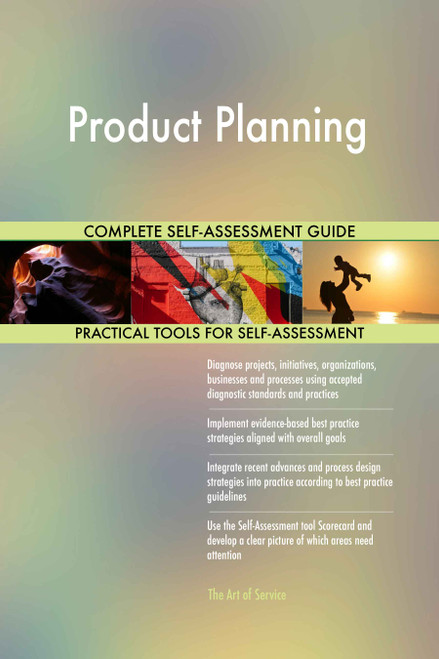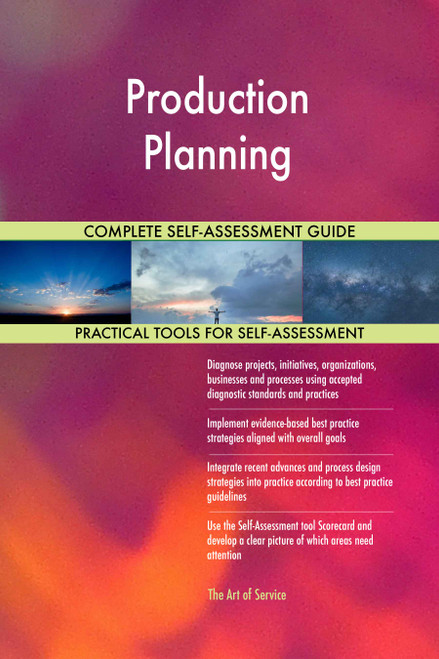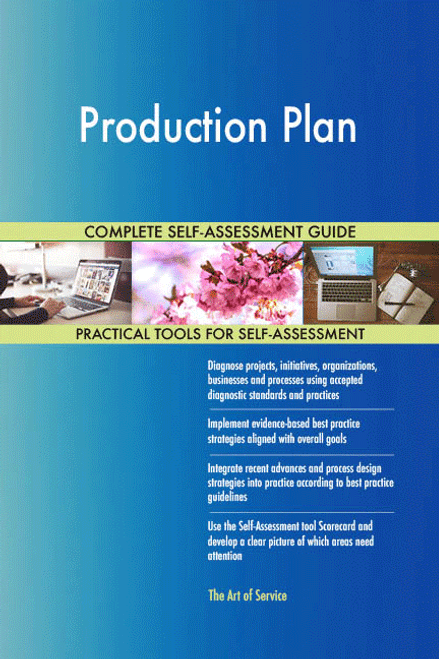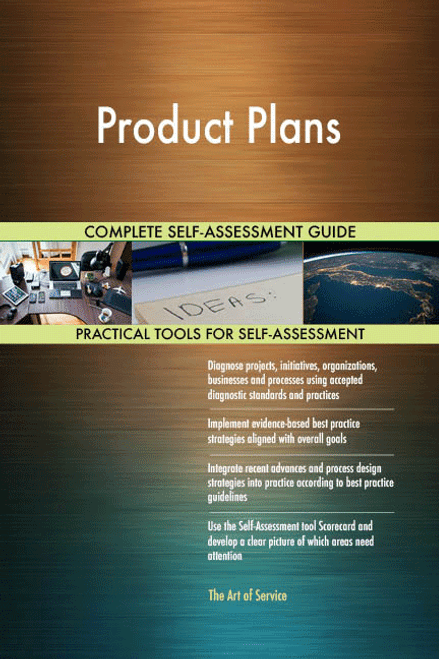Formulate Product Based Planning: software Quality Assurance, test coordination and test execution.
More Uses of the Product Based Planning Toolkit:
- Execute and deliver the Product Strategy for the product by working closely with Product leadership and cross functional teams.
- Provide PKI expertise and guidance to product Development Teams, security architects, and security champions throughout all phases of the Software Development life cycle.
- Assure your organization leads development, testing, deployments, and iterative improvement of product capabilities and features in collaboration with designers, Product Managers, and other engineers on the product team.
- Represent the Voice of the customer to influence Product Direction and inform your Sales And Marketing efforts.
- Govern Product Based Planning: interface with the product and other functional teams and leadership to deliver new features and services against Product Roadmap.
- Collaborate with Product Managers, Software Developers, and other stakeholders through ideation, design, and testing of new products and features.
- Maintain ongoing contact with sales staff, Supply Chain, manufacturing, and engineering to receive feedback regarding all aspects of workflow as shipment dates, special needs, product updates, feasible improvements, and problems.
- Direct Product Based Planning: plan, source, make/deliver, deploy and related support functions, as Master Data management or Product Lifecycle Management, in a high tech environment.
- Orchestrate Product Based Planning: participation and influence in review and execution of engineering change orders or deviations impacting material availability, material obsolescence, product configuration, Product Performance, and production throughput.
- Ensure your planning prepares and publishes products and digital assets to the website in collaboration with the Merchant Team to adhere to product launch guidelines and deadlines.
- Ensure your business promotes Agile team management where appropriate, by performing sprint and release planning; ensuring roadblocks are addressed; facilitating ceremonies and project retrospectives; and supporting the Product Owner in managing customer expectations for project backlog and deliverables.
- Direct Product Based Planning: product inspection and related documentation creation and maintenance.
- Manage product and platform teams performing Penetration Tests on new products.
- Perform product definition, System Architecture, requirements writing, Requirements Management, Requirements Analysis, Risk Analysis, Hazard Analysis, product test and evaluation, System V and V, and/or Design Control documentation.
- Provide interpretation, guidance and strategies on technologies and methodologies affecting product approvals, development and continued product compliance.
- Help maintain Competitive Analysis, monitoring trends, analyzing performance of assigned products and contribute to new product ideas.
- Perform product demonstrations and communicate design strategies to Sales Executives.
- Warrant that your organization designs, develop, and implements cost effective methods of testing and troubleshooting systems and equipment for all phases of Product Development and manufacturing.
- Initiate Product Based Planning: plan, scope and execute Application Security review and engage with Product Teams and developers to clarify security requirements.
- Maintain integrity of Product Catalog and make updates.
- Audit Product Based Planning: a technical Program Management must have superior Communication Skills to translate between the direction the executives and Product Managers want to go, what the Product Development team should implement, and how Marketing And Sales teams should sell it.
- Guide Product Based Planning: work closely with the sales team, Product Development, business unit leaders, sales, finance and marketing to strategize more effective sales and growth methods.
- Establish that your strategy uses high level of judgment to make decisions and handle complex tasks or problems in areas of operational, Product Management, manufacturing, technology or engineering.
- Confirm your organization provides technical solutions to detail certain aspects of Product Design and ensures that resulting design specification fits into technical architectural framework.
- Manage work with other Developers, Interactive Designers, and Product Managers to establish project timelines.
- Provide quality input for Product Development, manufacturing, and external suppliers as they relate to the companies solutions and products.
- Investigate new technologies and implementation in your products, providing relevant ideas and suggestions to Product Owners.
- Identify Product Based Planning: act as the Voice of the customer and use Customer Feedback to help product and engineering improve the product.
- Establish Product Based Planning: act as a liaison between the team and everyone else to minimize interruptions to the sprint, keeping the team focused on delivering a quality product on time.
- Ensure you execute; lead Failure Analysis activities for incidents originating from reliability testing for New Product Development and from fielded systems.
- Be accountable for preparing a variety of recurring, budget and accounting reports based on established practice.
- Coordinate activities through planning with department managers to ensure your organization objectives are accomplished in a timely and cost effective manner.
- Confirm your organization ensures that all systems are operated in accordance with best commercial practices with regard to Account Management, password management, physical/remote access, auditing, Data integrity, segregation and protection of customer confidential information.
Save time, empower your teams and effectively upgrade your processes with access to this practical Product Based Planning Toolkit and guide. Address common challenges with best-practice templates, step-by-step Work Plans and maturity diagnostics for any Product Based Planning related project.
Download the Toolkit and in Three Steps you will be guided from idea to implementation results.
The Toolkit contains the following practical and powerful enablers with new and updated Product Based Planning specific requirements:
STEP 1: Get your bearings
Start with...
- The latest quick edition of the Product Based Planning Self Assessment book in PDF containing 49 requirements to perform a quickscan, get an overview and share with stakeholders.
Organized in a Data Driven improvement cycle RDMAICS (Recognize, Define, Measure, Analyze, Improve, Control and Sustain), check the…
- Example pre-filled Self-Assessment Excel Dashboard to get familiar with results generation
Then find your goals...
STEP 2: Set concrete goals, tasks, dates and numbers you can track
Featuring 999 new and updated case-based questions, organized into seven core areas of Process Design, this Self-Assessment will help you identify areas in which Product Based Planning improvements can be made.
Examples; 10 of the 999 standard requirements:
- Do you need to do a usability evaluation?
- Is there an established Change Management process?
- How do you take a forward-looking perspective in identifying Product Based Planning research related to market response and models?
- Who defines the rules in relation to any given issue?
- What is your organizations process which leads to recognition of value generation?
- What are the strategic priorities for this year?
- Who will be responsible for deciding whether Product Based Planning goes ahead or not after the initial investigations?
- What is the magnitude of the improvements?
- Does the scope remain the same?
- How is Knowledge Sharing about Risk Management improved?
Complete the self assessment, on your own or with a team in a workshop setting. Use the workbook together with the self assessment requirements spreadsheet:
- The workbook is the latest in-depth complete edition of the Product Based Planning book in PDF containing 994 requirements, which criteria correspond to the criteria in...
Your Product Based Planning self-assessment dashboard which gives you your dynamically prioritized projects-ready tool and shows your organization exactly what to do next:
- The Self-Assessment Excel Dashboard; with the Product Based Planning Self-Assessment and Scorecard you will develop a clear picture of which Product Based Planning areas need attention, which requirements you should focus on and who will be responsible for them:
- Shows your organization instant insight in areas for improvement: Auto generates reports, radar chart for maturity assessment, insights per process and participant and bespoke, ready to use, RACI Matrix
- Gives you a professional Dashboard to guide and perform a thorough Product Based Planning Self-Assessment
- Is secure: Ensures offline Data Protection of your Self-Assessment results
- Dynamically prioritized projects-ready RACI Matrix shows your organization exactly what to do next:
STEP 3: Implement, Track, follow up and revise strategy
The outcomes of STEP 2, the self assessment, are the inputs for STEP 3; Start and manage Product Based Planning projects with the 62 implementation resources:
- 62 step-by-step Product Based Planning Project Management Form Templates covering over 1500 Product Based Planning project requirements and success criteria:
Examples; 10 of the check box criteria:
- Cost Management Plan: Eac -estimate at completion, what is the total job expected to cost?
- Activity Cost Estimates: In which phase of the Acquisition Process cycle does source qualifications reside?
- Project Scope Statement: Will all Product Based Planning project issues be unconditionally tracked through the Issue Resolution process?
- Closing Process Group: Did the Product Based Planning Project Team have enough people to execute the Product Based Planning project plan?
- Source Selection Criteria: What are the guidelines regarding award without considerations?
- Scope Management Plan: Are Corrective Actions taken when actual results are substantially different from detailed Product Based Planning project plan (variances)?
- Initiating Process Group: During which stage of Risk planning are risks prioritized based on probability and impact?
- Cost Management Plan: Is your organization certified as a supplier, wholesaler, regular dealer, or manufacturer of corresponding products/supplies?
- Procurement Audit: Was a formal review of tenders received undertaken?
- Activity Cost Estimates: What procedures are put in place regarding bidding and cost comparisons, if any?
Step-by-step and complete Product Based Planning Project Management Forms and Templates including check box criteria and templates.
1.0 Initiating Process Group:
- 1.1 Product Based Planning project Charter
- 1.2 Stakeholder Register
- 1.3 Stakeholder Analysis Matrix
2.0 Planning Process Group:
- 2.1 Product Based Planning Project Management Plan
- 2.2 Scope Management Plan
- 2.3 Requirements Management Plan
- 2.4 Requirements Documentation
- 2.5 Requirements Traceability Matrix
- 2.6 Product Based Planning project Scope Statement
- 2.7 Assumption and Constraint Log
- 2.8 Work Breakdown Structure
- 2.9 WBS Dictionary
- 2.10 Schedule Management Plan
- 2.11 Activity List
- 2.12 Activity Attributes
- 2.13 Milestone List
- 2.14 Network Diagram
- 2.15 Activity Resource Requirements
- 2.16 Resource Breakdown Structure
- 2.17 Activity Duration Estimates
- 2.18 Duration Estimating Worksheet
- 2.19 Product Based Planning project Schedule
- 2.20 Cost Management Plan
- 2.21 Activity Cost Estimates
- 2.22 Cost Estimating Worksheet
- 2.23 Cost Baseline
- 2.24 Quality Management Plan
- 2.25 Quality Metrics
- 2.26 Process Improvement Plan
- 2.27 Responsibility Assignment Matrix
- 2.28 Roles and Responsibilities
- 2.29 Human Resource Management Plan
- 2.30 Communications Management Plan
- 2.31 Risk Management Plan
- 2.32 Risk Register
- 2.33 Probability and Impact Assessment
- 2.34 Probability and Impact Matrix
- 2.35 Risk Data Sheet
- 2.36 Procurement Management Plan
- 2.37 Source Selection Criteria
- 2.38 Stakeholder Management Plan
- 2.39 Change Management Plan
3.0 Executing Process Group:
- 3.1 Team Member Status Report
- 3.2 Change Request
- 3.3 Change Log
- 3.4 Decision Log
- 3.5 Quality Audit
- 3.6 Team Directory
- 3.7 Team Operating Agreement
- 3.8 Team Performance Assessment
- 3.9 Team Member Performance Assessment
- 3.10 Issue Log
4.0 Monitoring and Controlling Process Group:
- 4.1 Product Based Planning project Performance Report
- 4.2 Variance Analysis
- 4.3 Earned Value Status
- 4.4 Risk Audit
- 4.5 Contractor Status Report
- 4.6 Formal Acceptance
5.0 Closing Process Group:
- 5.1 Procurement Audit
- 5.2 Contract Close-Out
- 5.3 Product Based Planning project or Phase Close-Out
- 5.4 Lessons Learned
Results
With this Three Step process you will have all the tools you need for any Product Based Planning project with this in-depth Product Based Planning Toolkit.
In using the Toolkit you will be better able to:
- Diagnose Product Based Planning projects, initiatives, organizations, businesses and processes using accepted diagnostic standards and practices
- Implement evidence-based Best Practice strategies aligned with overall goals
- Integrate recent advances in Product Based Planning and put Process Design strategies into practice according to Best Practice guidelines
Defining, designing, creating, and implementing a process to solve a business challenge or meet a business objective is the most valuable role; In EVERY company, organization and department.
Unless you are talking a one-time, single-use project within a business, there should be a process. Whether that process is managed and implemented by humans, AI, or a combination of the two, it needs to be designed by someone with a complex enough perspective to ask the right questions. Someone capable of asking the right questions and step back and say, 'What are we really trying to accomplish here? And is there a different way to look at it?'
This Toolkit empowers people to do just that - whether their title is entrepreneur, manager, consultant, (Vice-)President, CxO etc... - they are the people who rule the future. They are the person who asks the right questions to make Product Based Planning investments work better.
This Product Based Planning All-Inclusive Toolkit enables You to be that person.
Includes lifetime updates
Every self assessment comes with Lifetime Updates and Lifetime Free Updated Books. Lifetime Updates is an industry-first feature which allows you to receive verified self assessment updates, ensuring you always have the most accurate information at your fingertips.







